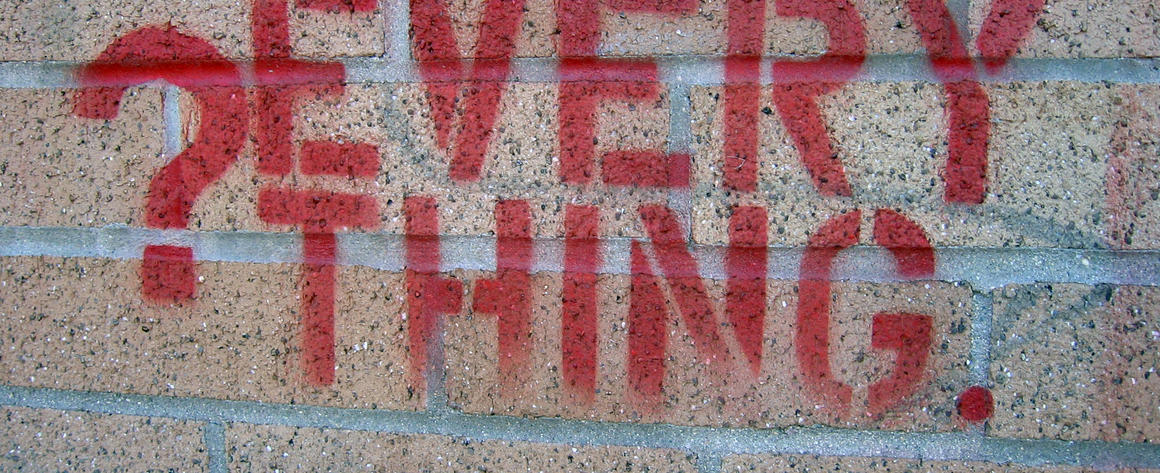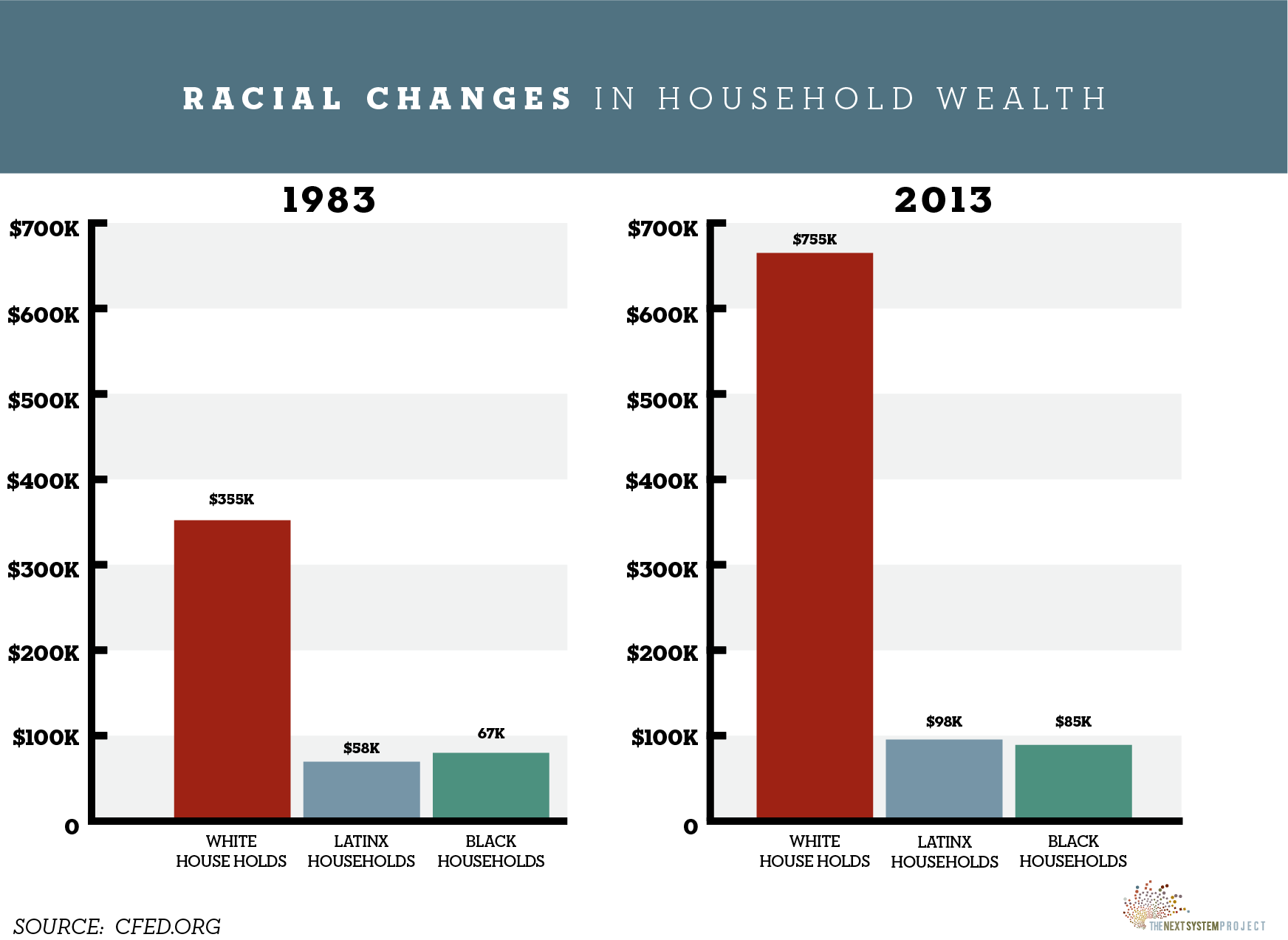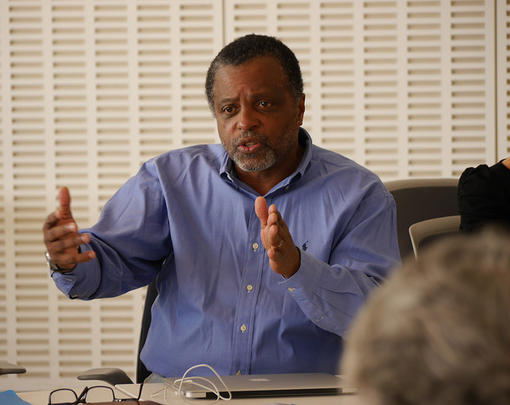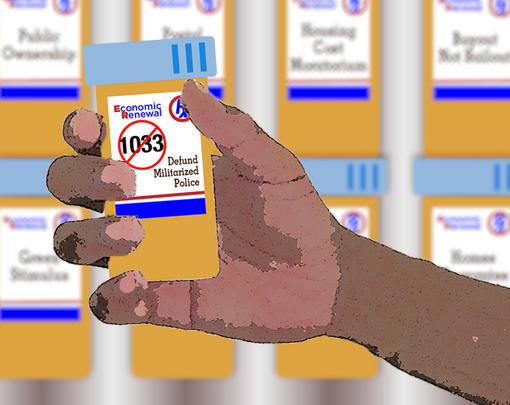William A. Darity Jr. is the Samuel DuBois Cook Professor of Public Policy, African and African American Studies, and Economics and the director of the Samuel DuBois Cook Center on Social Equity at Duke University. The focus of his work is on inequality based on race, class, and ethnicity. He has been published in The Atlantic, The New York Times, and most recently Jacobin Magazine. He is currently co-writing with Kristen Mullen a new book about reparations for African Americans, From Here to Equality, hoped to be released by Fall of 2017.
The Next System Project’s Adam Simpson and Carla Skandier sat down with William Darity for a conversation about his proposed reparations program to African Americans and the social and economic issues underlying the program. The interview has been edited for clarity and flow.
At first, a skeptic
Carla Skandier: You are currently writing a book about reparations for African Americans, an issue you have been writing for the past decades. Can you share with us how did you come to understand the issue of reparations and how did you become an advocate for the program?
William Darity: Originally, I was asked by a researcher named Richard F. America to write the introduction for a collection of essays that he had edited for a volume ultimately called The Wealth of Races. This was early 1990s probably, or late-1980s. America asked me to do an introduction for this collection of essays, and I was a skeptic about reparations, but the essays were all on various dimensions of issues surrounding reparations including the question of how much the amount of a reparations bill should be, using work that calculated those estimates in a number of different ways. There was some discussion of the appropriateness of reparations in the essays, as well.
It was in the process of reading those essays and thinking about them that I began to say, “Well, actually, this is the correct thing to do.” I have to attribute this [changed understanding of reparations] to Richard America’s request that I write the introduction to a set of essays about something that I was very skeptical about at the time. I changed my mind in the process of looking at these essays.
Adam Simpson: Do you recall what made you skeptical at the time? That might be interesting as a theory of change moving forward.
William Darity: I think I was skeptical because I simply took the position that many, many people have; that [reparations for African Americans] is so far out of the box that it will never happen. It may never happen, but I think it is something that is worth fighting for. In the process of reading those essays, I think I just had a sense of the profundity of the case for reparations being so great that there was no reason to say that one shouldn’t pursue this simply because it may look like something that may not happen very easily.
Adam Simpson: Before we get straight to the issue of reparations I think it would be useful to understand a little bit more the work you’ve done on racial distribution of wealth. I’ve been reading through your work and I’ve even seen some of your lectures and YouTube videos. In particular, I saw you refer to yourself as a “Stratification Economist.” How does this kind of work inform your perspective on reparations? Do you view reparations completely separate from addressing the racial inequality or they’re very much connected in your mind?
William Darity: I think [the racial distribution of wealth and reparations] are very much connected. I think that the growing interest on my part in reparations is actually what propelled me to pay closer and closer attention to racial wealth inequality. I certainly think that one of the objectives of a sound reparations program should be closing the racial wealth gap. In fact, I think that’s an important objective. It’s apparent to me that there are other ways to go about doing that but I think it’s essential to design a reparations program that would pay very close attention to racial wealth differences, the magnitude of racial wealth differences, the impact of racial wealth differences, and how we go about actually closing those gaps.
Carla Skandier: For the purpose of clarity, can you explain the distinction between income and wealth?
William Darity: Yes. Income is a flow concept of resources that come to an individual within a particular period of time. Usually we think about it on an annual basis but that’s an arbitrary division of time. Most of income for most people is typically earnings, although there could be income that’s received in the form of transfer payments from the government, for folks that are at the lower end of the scale. There could be income that’s received from interest on assets for folks who, typically, are at the upper end of the scale. But these are a flow of resources in contrast with wealth, which is a stock of resources. The stock of resources is measured by taking the difference between what an individual owns and what an individual owes. Another way of putting it: the net worth that an individual possesses or a household possesses, which is the difference between the value of their assets and the value of their debts.
Wealth is actually a much stronger indicator of the degree of economic security of a household, an individual, or a family because it’s via wealth that you have the capacity to move with greater degrees of security across time. A wealthier household is one that’s going to be able to weather financial emergencies, whether it’s an emergency caused by the loss of a job, which eliminates income, or because of a major medical crisis that confronts a family with extraordinary expenses. Indeed, even if you have health insurance, the quality of your health insurance is generally contingent on your capacity to pay for it, and wealthier households generally have a greater ability to get a higher quality health insurance.
Wealthier households can also move into neighborhoods with superior amenities, including superior schools. They can also opt, instead of putting their kids in a public school, to put their children in high-quality private schools. They can do that much more easily than families that don’t have a high wealth position. They can also transfer resources to the next generation via either inheritances or gifts that are given to sons and daughters while the parents are still living.
So, there’s a number of ways in which wealth plays out as a very, very important indicator of economic security or reduced economic vulnerability.
Reparations beyond slavery
Carla Skandier: Jumping to the specifics of your proposed reparations program: Can you discuss what the concept of reparations means to you, and what are the goals of your program?
William Darity: In the book From Here to Equality that I’m working with Kirsten Mullen, who happens to be my wife, we say that a reparations program should accomplish three ends. One is acknowledgement. A second is restitution. And the third is closure. There is actually an acronym for those objectives - ARC.
Acknowledgement involves the recognition on the part of the beneficiaries of the social injustice that’s in question; an acknowledgement on the part of the beneficiaries of that social injustice that there has been a wrong committed and that there must be some form of repair to be provided to the folks who are the victims of that injustice. Restitution constitutes the actual program that’s enacted to undertake that form of repair. Closure constitutes the acknowledgement on the part of the victimized community that they have received a satisfactory act of compensation from the victimizers, and that they have no reason to request anything that’s specifically for their group in the future, unless there’s a new wave of injustices.
Adam Simpson: A lot of times when I’ve spoken to people about the reparations issue the conversation is almost exclusively about the issue of slavery. People will say, “The victims are long since deceased, as well as their perpetrators.” Does your understanding of reparations confront and address wrongs like redlining, Jim Crow, and other abuses perpetrated against Black Americans, or is it tied specifically to slavery?
William Darity: No. It’s not tied specifically to slavery. In fact, in our book we try to make the argument that injustices that occurred after slavery are, at least, as important for building the case for reparations. Start with the failure to fulfill the commitment to provide the ex-slaves with 40 acres and a mule, or some form of reparations in the immediate aftermath of slavery. That failure triggered a host of events subsequently that lay at the heart of the huge racial disparities we observe today. Yes, redlining matters. The whole set of conditions that Ira Katznelson has called the circumstances “when affirmative action was white,” including the racialized nature of the provision of the benefits of the GI Bill, and a host of instances where black communities that had built a prosperous business and social foundation were razed to the ground, literally. Examples include Tulsa, Oklahoma in 1921, and Wilmington, North Carolina in 1898, when communities where black folks were trying to build a foundation for some significant amount of prosperity were destroyed. We also have to take into account the process of the destruction of some black communities’ business districts by the use of Federal highway legislation, where highways were run right through the heart of the business districts in these communities, eliminating them. My hometown of Durham, North Carolina is a case-in-point.
Yes, there’s a host of things that took place. The whole history of lynching in the United States. There’s a host of things that took place after slavery that we have yet to take into account. I would be inclined to argue that the basis for reparations is slavery, Jim Crow, and ongoing discrimination and racism in the United States. It may be the case that the Jim Crow period is the strongest foundation for a reparation’s program of the three, but I also think that the claim that slavery happened so long ago and no one living today was either enslaved or engaged in the process of enslavement is a misleading argument because the effects and repercussions of slavery persist to the present day. The process of black victimization is one that did not end with the end of slavery.
Carla Skandier: In previous works, you’ve outlined a reparations program that would require individuals to establish that they are indeed descendants of persons formerly enslaved in the United States. Considering that a reparations program would not only correct the wrongs done for slavery, but also ongoing discrimination, how would this eligibility criteria for a reparations program work? Do you see any tension between African Americans that could not prove that they are descendants of slaves?
William Darity: Actually, there’s two prongs to the criteria. One is that an individual would have to establish that they had an ancestor who was enslaved in the United States. But the second prong is that an individual would have to demonstrate that they self-described themselves as Black, Colored, African American, or Negro at least ten years prior to the onset of the program. The second criteria is in place to avoid having people suddenly announce that they are black in the aftermath of the reparations program just so that they can get the benefits of it. But the first criterion, that an individual would have to establish they have an enslaved ancestor in the United States, is intended to address the question of forced migration to the United States, excluding post-slavery black immigrants from other parts of the world who came to the United States on a voluntary basis.
The critical distinction that I want to make is the folks who have a history of ancestry that’s tied to enslavement in the United States are folks who have a history of ancestry that’s tied to coerced migration to the United States. I think that’s a critical distinction. I think that is the population who has to be identified as the truly victimized population in the process of thinking about whom should receive reparations.
Adam Simpson: When it comes to practice, how does one go about accounting the value of the history of enslavement, the Jim Crow era, and the myriad numbers of abuses that black Americans have endured?
William Darity: There’s a number of ways in which this kind of estimate can be calculated. Some of them could be anchored on slavery alone. One of these ways of trying to estimate it is to look at what the value of enslaved human property constituted for the slave owners, and then you could take that sum, adjust it upwards to get a present value calculation of the amount, and say that that’s the amount. Another approach is to say that there was some discrepancy between the amount of compensation that the slaves received, which was essentially a zero wage, versus whatever the slave holders put up for the purposes of subsistence or maintenance of their enslaved population, and you could say that the missing wages net of whatever the enslavers provided constitutes a bill that is owed, and that could be the foundation for constructing an estimate, again, taking that sum of money and transforming it into a present value calculation.
Another approach is to say “well let’s look at the wealth that was lost by the failure to provide the 40 acres and a mule in the aftermath of enslavement”. That could be the foundation for the calculation. We could also look at various kinds of wealth that were lost or destroyed in the period after slavery ended and use those monetary estimates as the basis for calculating the entire bill.
There’s a number of avenues for trying to do this once we make a commitment that reparations is something that should be done.
Paradigms of reparations
Adam Simpson: It strikes me that this question has a lot of approaches, but it might be just one more reason why John Conyer’s Bill HR 40 [“Commission to Study Reparation Proposals for African Americans Act”] might be so crucial in advancing our understanding of it?
William Darity: I think that’s absolutely right that one of the issues that, hopefully, such a Commission might address is what are the best ways to go about calculating the bill.
Carla Skandier: So moving beyond what’s wrong and accounting for what’s wrong, what are the forms of reparations you envision for African Americans?
William Darity: In one of the papers that I’ve written I talked about something that I’ve called, “The Portfolios of Reparations.” I think it’s virtually essential that some part in the way which reparations are paid out constitutes what people refer to as a check to all eligible Americans. But then I also think that there could be other forms of the use of the total reparations package for various kinds of institution building. For example, in the context of the reparations that were provided to the Jewish victims of the Holocaust, there was a component of that reparations that was actually used for the purposes of supporting the State of Israel.
I think, similarly, there could be internal institutions in the United States that were developed on behalf of supporting economic improvement within the black community that could be provided as a part of the reparations program. We could even structure this so that individual black Americans could submit proposals for business development or other types of initiatives that could be funded out of a reparations fund. I actually think that the delivery of reparations in the United States to black Americans ought to have multiple facets, but I think one of the essential facets is the actual payment of an out-and-out check to all eligible African Americans.
Adam Simpson: In yours and Frank’s 2005 discussion of The Economics of Reparations, I was really struck by your suggestion that if reparations were only in the form of a lump sum that could actually promote a decline in black wealth. How would that occur?
William Darity: It would depend upon whether or not reparations are provided in the form of income or in the form of an asset. If it’s provided in the form of income than you hit the classic transfer problem, which is - to the extent that we don’t have a well-developed apparatus of black enterprise in the United States—no major black-owned corporation would ultimately benefit if there’s exclusively an income flow. That income would be used to purchase goods and services that are generally going to be provided by white-owned corporations. In some sense, the money would go back into the hands of the white population.
Some people might think that that’s fine because it would be an economic stimulus of some sort, and, of course, black folks would get the benefit of whatever goods and services they have or purchase. But if we’re concerned about longer-term economic security then we would need to have some sort of mechanism for asset building in the black community. I think the key question is what form do reparations take if we’re going to provide people with the equivalent of a check?; is it a check that takes the form exclusively of an income payment or does it take the form of some sort of asset building opportunity?
Dave Chappelle made this point on his comedy show. There’s a paper of mine coauthored with Bidisha Lahiri and Dania Francis, where we refer to the result of returning funds to white-owned corporations as “the Chappelle Effect.”
Adam Simpson: Of all the things I did not expected to talk about today was the Chappelle Show! I really appreciate that. The next question is about process. If we agree that reparations are just, we can probably work this out one way or another, but do you have in mind how we might finance a reparations program? What kind of taxes and how would we protect African Americans from paying for their own reparation?
William Darity: I’m going to have to be a little bit circumspect about this because one of the key features of our new book is the chapter that details how you might actually execute a reparations program, and it includes the discussion of the question of how you might finance it.
But I will say this much. The bill is obviously going to be enormous. Any of these means of calculations that I’ve described leads to very large sums of money, particularly if you go beyond the slavery period and do estimates that are based upon the kinds of injustices that destroyed black wealth and prosperity in the aftermath of slavery. The sum is going to be quite large. One possible way of thinking about how to do this most effectively is to say that you don’t pay it out all at once. You can structure the system so that there’s a series of payments over a number of years. That would make it more feasible to manage economically. If those payments were associated with asset building, in particular, then what you’re actually doing is creating a more sustained period of economic security for larger and larger numbers of black Americans.
Carla Skandier: As you mentioned a number of countries have adopted a form of reparations, such as the Germans in the aftermath of the Holocaust. I was wondering if there are any lessons learned from past precedents, and how they influence the development of your own reparations proposal?
William Darity: I think one of the most relevant precedents is one that involved relatively modest payments, but it’s an American precedent. It’s the provision of reparations to Japanese Americans, who were incarcerated during World War II simply because they were of Japanese ancestry. There was a whole gambit that was used to make the claim that they were a threat to American society because, allegedly, they were going to be sympathetic or sympathizers with the Japanese government, but it’s of note that German Americans were not rounded up and incarcerated. Italian Americans were not rounded up and incarcerated. Going back to the point that Adam made about the John Conyers’ Commission, the first thing that occurred to facilitate the development of the Japanese reparations program was the formation of a commission [Commission of Wartime Relocation and Internment of Civilians]. Later the Commission established, unequivocally, that the Japanese Americans did not constitute a threat to America at the point in which they were incarcerated, and, moreover, that Americans officials knew that they were not actually a threat at the time.
The Commission’s report [Personal Justice Denied] was critical in enabling the development of a program of reparations for Japanese Americans. To the best of my recollection, the program paid out about $20,000 to each of the individuals who were identified as living victims, at the time, of incarceration events. There were also some resources that were provided to family members, I believe. And then, also, this is something that is very critical before and after the establishment of a reparations program, there was supposed to be a research center that was established in a museum-type fashion to provide a sustained memory of the event and also explore and investigate other kinds of atrocities that have occurred throughout the world and throughout the United States.
I believe such a museum exists, but it’s not particularly visible because when I talk to people about it, most people have never heard of it. I think it’s really important that there’s an educational dimension to this process, an educational dimension that would need to take place before a reparations program could be seriously considered, but also an educational process that would have to follow the formation of a reparations program. When we talk about closure, we do not mean forgetting. There need to be mechanisms that institutionalize the memory of this particular history with an eye towards trying to ensure that these kinds of injustices are not replicated. That’s something that I think I take as a lesson from other experiences with reparations. Particularly in the Japanese American experience is the importance of having a highly visible, highly active educational process put in place to maintain the memory of these kinds of historical events.
Adam Simpson: The United States has paid reparations to Native Americans, and we just discussed the Japanese precedent as well. However, we have difficulty just getting John Conyers’ H.R. 40 passed. When the Japanese reparations program began in 1988, it wasn’t as if there was a large representative portion of Asian Americans in Congress or anything like that. Why do you think, it seems, that when it comes to restitution to African Americans the United States government remains hesitant? What it is about the abuses against African Americans that, uniquely it seems, causes such hesitation?
William Darity: I think there’s a narrative that is drafted in the United States, which frequently suggests that black Americans are responsible for their own condition of deprivation. Even the former President Barack Obama routinely made use of these notions that there’s some sort of cultural dysfunctionality in the black community, urging young black men to pull up their pants and all that sort of thing. I think that there’s some sense that black Americans are not deserving of reparations because they bear responsibility for their own condition. In this narrative blacks are not seen as victims; in fact, there’s a lot of urging that it’s psychologically damaging to treat one’s self or to view one’s self as a victim.
I think that’s a mistaken perspective on a number of levels. But I especially think that if you see yourself as a victim, you are going to make the case for overcoming that victimization by receiving acknowledgement that you have been a victim and compensation for that victimization. I hope we would not tell a woman who has been subjected to rape to just get over it without receiving any kind of acknowledgement of the harm that’s been done to her and any form of compensation for this harm.
Of course, there’s no level of compensation that can overcome these types of injustices or pay you back for them in full. But there is a level of compensation that can be made that can put you in a position to participate in the society on an equitable and fair basis. That’s what we need to do. But I really think it’s because there’s an ideological position that’s being taken about black Americans bearing responsibility for their own situation of inequality that plays a deep role in the resistance to reparations for black Americans. To the extent that this narrative weakens, then it becomes possible to have a more serious consideration of the prospects of reparations.
I will add this. In the early 1990s when Michael Dawson and Rovana Popoff did a study on American attitudes towards reparations for black Americans, only about 4% of white Americans said that they were in favor for reparations for black Americans. That means 96% were against it. I think today it’s closer to 20% of White Americans who would contemplate, or seriously consider, reparations for African Americans. I view that as a significant progress. The question is: can we move the needle to 40%, 45%, in which it becomes possible to seriously contemplate congressional legislation? Can we move the needle to 40%, 45% despite the Trump presidency?
Carla Skandier: You just mentioned the flawed narrative of the racial wealth gap. Could you explain a little bit more what your theory of change is? How can we change this narrative and move the needle to a point where we get the majority of people open to a discussion about a reparations program to African Americans? Do you think is the legislative power that needs to change first, or public sentiment, or any particular institution?
William Darity: I had said that the educational task is something that needs to take place before and after. The reason I think an educational task has to take place before is because I don’t think we will change American opinions significantly without doing that. I’m not sure we will by doing that, but we definitely won’t if we don’t. In particular, we have to change the American understanding of why racial inequality persists, but we also have to address the American understanding of the nature of the Confederacy because I think that also lays at the heart of the refusal to consider reparations for black Americans. I think we have romanticized the Confederacy in such a way that it diminishes the horror of slavery. I think that is something that has to be taken on as well.
Now, the question is how you go about doing this, undertaking this educational mission? Well, I would think that a commission like the one that Conyers’ HR 40 seeks to establish could play a valuable part by providing an official record of the historical injustices that have taken place in the United States — and connecting those injustices to the inequalities that exist now. That’s entirely separate in a way, from the question of crafting a reparations program.
I think the first thing that has to be done is to craft a new and more accurate narrative about the causes and effects of racial disparities in the United States.
Baby Bonds, Basic Income, & the Job Guarantee
Adam Simpson: You briefly mentioned the new political context, with Trump’s Administration somewhat looming over our heads. If we want to emphasize individuals and communities as the agents of change—and think about change from a bottom-up perspective because we may not have much faith in a top-down strategy of change at the moment—do you have any thoughts on how communities, cities, organizations, and individuals can advance these themes that we’ve talked about? The reparations program and how to move the needle somewhat?
William Darity: Well, I think that there are a couple of things about the entry points. One is to get a number of cities and establish a set of legislative requirements that if they were going to contract with a particular corporation that corporation would have to provide a historical analysis of its relationship to slavery. We do have some already doing this. I think the City of Chicago is one in which this has been done, but I’m not sure what use actually has been made of those reports. I think that at the local level, to the extent that those reports exist, there’s a need for local communities to examine them closely, and to see if there are other institutions that need to develop that type of historical record. I think that’s something that could be done at the local-level, particularly if a specific corporation is based within your municipality.
The second thing is that we are having a growth in the number of cases at colleges and universities, where those institutions formed prior to the end of slavery are now becoming more open in revealing, under pressure, their historical connections to slavery and the slave trade. I went to Brown University, and Brown’s President a few years ago, Ruth Simmons, actively set up a research group that was intended to provide an official report to the University about its connections to slavery and the slave trade. That report actually was completed, but it had some relatively mild recommendations for steps Brown to take in atonement. Still I think that the Brown experience indicates how a number of colleges and universities can seize the opportunity for student and faculty groups, administrators, and staff members to come together and examine the specifics of the history of their institution. They can see what their institution’s history also tells them about the national history as well, and they can think about ways in which their institutions can become, I would propose, advocates for reparations for all black Americans.
In fact, when I think about institutions like Georgetown University, which has recently acknowledged that in the 1830s the priests who ran the university sold enslaved Africans to the South for the purposes of keeping the university afloat financially, I think that it definitely should become one of the institutions pressured to be involved in the process of advocating reparations for black Americans on a national level. I think that municipal histories, the histories that are associated with specific colleges and universities, provide a vehicle for trying to think about these kinds of issues and to facilitate building the momentum for reparations, by starting at the local level.
Adam Simpson: That’s fascinating. I have a thousand questions about those initiatives but we can move to my next question. This might play to what you referred to as, “A Portfolio of Reparations,” but I’ve heard both Ta-Nehisi Coates and the Movement for Black Lives suggest that broad social programs like free universal healthcare or free universal college education, although they would serve more than just African Americans, would disproportionately benefit African Americans, and could serve as programs within a reparation’s agenda if we admitted that this is what they were for. The acknowledgement component you referred to under your reparations program. I was wondering if those proposals seemed appropriate to you, why or why not? I think most people probably think of programs and initiatives that are not universal when they think about reparations.
William Darity: I think that’s the key point and that’s why we describe closure as meaning that the group who receives the compensation no longer makes any group-specific claims on the nation, or on the entity that has perpetrated the injustice unless, as I’ve said of course, new injustices occur. But yes, reparations is intrinsically a group-specific policy because a specific group is subjected to the victimization. If you provide compensation to Japanese Americans for being incarcerated during World War II it’s because Japanese Americans were the ones who were incarcerated during World War II.
That said, there are varieties of universal programs that could replicate some of the positive effects of a reparations program. This is precisely because they could be designed in such a way that they would disproportionally benefit black Americans. One of the programs of this type that I’ve been talking about is something Darrick Hamilton and I have called, “The Baby Bonds Proposal.” It’s not really a bond, but a trust fund that would be provided to each new born infant. It would be a publicly provided trust fund. The amount of that trust fund would vary with the wealth position of the child’s family. In my standard stump speech I say, if Bill Gates had a new child, we’d give that child a $50 trust fund. But if a child is born into a family at the lowest end of the wealth distribution, they would get a $50,000 to $60,000 trust fund. Because black families on average have considerably less wealth than white families, this kind of system or scheme would disproportionately benefit blacks. It would be universal but not uniformed.
I would still be loath to characterize something like that as a reparations program precisely because it is not directed specifically or exclusively at black Americans. It is not intended to address an entire history of injustice, but it is intended to try to address existing wealth inequalities.
Carla Skandier: That is interesting. I was discussing with Adam your Baby Bonds proposal, and I was curious about the connection between this and your reparations program because you seem to address them separately.
William Darity: In the best of all possible worlds we’d have both, and here’s why. Reparations is intended to address a specific set of injustices that were directed at a specific community, but we can always reproduce wealth inequalities across the entire population. It would be great to have a mechanism in place that continuously counteracted the reproduction of those wealth inequalities. They are different plans of action, but in my favorite world, we would have both.
Adam Simpson: The Baby Bonds seem in a certain sense, like a basic income although I gather it scales from what you’ve discussed. You recently published in Jacobin Magazine a piece about the Federal Job Guarantee along with some co-authors. I know that there is a tension between some economists and other thinkers about, do we want a job guarantee or a basic income? I know that the Movement for Black Lives has endorsed a basic income. I was wondering if you thought that the Federal Job Guarantee, now that I have this opening, can play some role in a more inclusive society and a more just society?
William Darity: I think of Baby Bonds and I also think of reparations to a large extent, as trying to address wealth inequalities. But I think the job guarantee or the basic income guarantee is something that is trying to address income inequalities. I like them all.
Adam Simpson: Fair enough. That’s interesting. I’m glad we came back full-circle to the distinction between wealth and income.
William Darity: That’s why I was emphasizing that a more dangerous form of reparations program is one in which the transfers that are made are exclusively on an income basis, as opposed to an asset-building basis.
I think of reparations as a way of trying to really get at the question that these huge wealth disparities exist on the basis of race. Okay, so that said, I have long been advocating for a Federal Job Guarantee. I don’t necessarily think that this is a program that is mutually exclusive from a basic income guarantee. Depending on the magnitude of the basic income guarantee, if it’s in the order that most people have talked about - which seems to be something like $10,000 or $12,000 - we’re in a better situation if we have the job guarantee without the income guarantee than we would be in a situation where we have the income guarantee without the job guarantee. The reason is quite simple. The income guarantee could effectively subsidize low-wage jobs. I don’t think that this is the intent of folks who support it, but I see that as a possible outcome. On the other hand, if we’re talking about an income guarantee in the vicinity of $30,000 then that’s a different ball game. Maybe then we wouldn’t need the job guarantee, I’m not sure. But I think one of the critical dimensions of thinking about the Universal Basic Income (UBI) is the question of how much it would actually be because it [the amount] could have different repercussions and implications.
Adam Simpson: Especially as some would prefer to hollow out the existing social safety net in exchange for a UBI.
William Darity: That’s right. It would be critical to know how much that UBI is.
Carla Skandier: Maybe you have already answered this indirectly, but can we achieve an equitable and just political economy without a reparations program? I’m assuming your answer is “No” as you see the difference between programs that are promoted as income or wealth equality, but maybe you have a different answer.
William Darity: If our focus is on trying to address a history of deep injustice then no, the answer is no. We can’t do what you’re describing without having some form of a reparations program. And the form of it is crucial because you could inaugurate something you call a reparations program that in reality is quite sterile. You need something that’s really substantial and effective. But if our goal is only to try to address the racial wealth gap, or wealth inequality in general, then there are ways to do that without necessarily inaugurating a reparations program. It depends on what the objectives are and what we have in mind in terms of characterizing our society as moving toward a greater degree of justice.
On Race & Capitalism
Carla Skandier: Can a reparations program actually prevent perpetuating race-based social and economic inequalities? How do you reach that final closure and make sure that moving forward there is no discrimination–and, therefore, nothing to repair for ongoing wrongs 10 years after a reparation program is in place?
William Darity: There’s no way of guaranteeing that, but I think the question you raised is one that is linked to my preference for trying to inaugurate a reparations program through Congressional action. I’m working on the assumption that you could not do this via a Congressional action unless there was sufficient political support for doing it nationally. And for us to have that kind of political support, I think we would be in a different racial climate from one that has ever existed in the United States before. I’m not so sure that 10 years down the road there wouldn’t be some form of backlash. But at the point at which a reparations program was adopted by Congress, there would have to be sufficient national sentiment and support for it that I don’t think there would be the same degree of inclination to reproduce the kinds of injustices that are taking place to this day. That’s the critical question; what kinds of attitudes would have to exist in American society as a whole for us to actually have a reparations program get inaugurated?
That’s also why I’m very reluctant to try to do this through the judiciary. The court system doesn’t really have the capacity to overcome a massive political resistance. A key example is the 1954 Brown v. Board of Education desegregation of schools case where, in its aftermath, the southern states collectively engaged in massive resistance. We didn’t really get any significant school desegregation in the South until the beginning of the 1970s. There’s a reason for saying, “This should be done legislatively rather than judicially.”
Adam Simpson: Our final question is about the broader system, about capitalism. Thinkers like Eric Williams, and even much more recently Edward Baptist, have argued that capitalism has always depended on a certain type of taxonomy that slavery embodied, and that the pattern continued after slavery through the creation of a carceral state, redlining, and all of the other things we’ve talked about. Maybe you disagree with this premise, but if capitalism is intrinsically, and not just accidentally, connected to racial difference as a critical component of inequality and accumulation, can reparations deliver on the promise of justice without challenging the systemic violence and inequality of capitalism itself?
William Darity: That’s a great question. I’m not sure if I have a good answer. Let me see if I can circle into this.
Obviously capitalism as a system is a system that’s predicated on a certain form of exploitation. Now, the question is does that form of exploitation have to involve exploitation on the basis of group affiliation? I’m not sure. I know historically that this has been the case, but I’m not sure if that always has to be the case. The kinds of policies that I’m talking about are not necessarily policies that would eliminate capitalism in the sense of eliminating the existence of profit-seeking enterprises. The policies would, in some major ways, attenuate the most adverse consequences of capitalism to the extent that capitalism generates inequalities. These kinds of plans of action that we’ve talked about today are intended to mitigate the degree of inequality that’s generated, the degree of unfairness.
I don’t know. Does capitalism have to be racialized as opposed to the question of has capitalism been racialized? It certainly has been up to the present moment. I honestly don’t know the answer, but I’m hoping that these types of policies that we’ve discussed are of the sort that regardless of whether or not capitalism remains racialized to some degree, the adverse consequences would be reduced substantially.
For more about William Darity’s work please check his on-going project, Bold Policies for Social Change, at Research Gate, and keep an eye out for his upcoming book, From Here to Equality, with co-author Kristen Mullen. You can also follow him on Twitter @SandyDarity.







